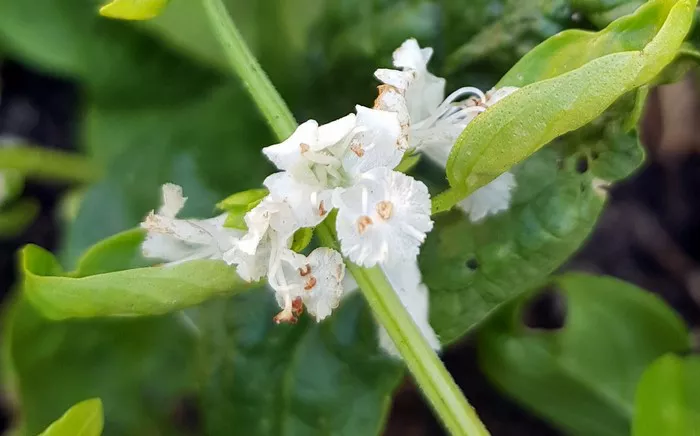Basil, with its aromatic leaves and distinctive flavor, is a beloved herb in kitchens worldwide. But beyond its leaves lies a culinary treasure often overlooked—the delicate and flavorful basil flowers. In this article, we delve into the world of basil flowers from three perspectives: their edibility, nutritional value, and how to incorporate them into delicious recipes.
Edibility of Basil Flowers
The question of whether basil flowers are edible is a common one, and the answer is a resounding yes. In fact, basil flowers not only add a burst of flavor to dishes but also offer a visual appeal that can elevate any culinary creation. However, it’s essential to ensure that the flowers are fresh and free from any pesticides or contaminants before consuming them.
Basil flowers boast a milder flavor compared to the leaves, making them versatile for various culinary applications. Their taste often carries subtle hints of the basil plant’s characteristic sweetness with a delicate floral undertone. When harvesting basil flowers for consumption, it’s best to pick them when they’re still in bud or just beginning to bloom, as this is when they are most tender and flavorful.
While the entire basil flower is edible, some prefer to remove the pistil, the tiny stem-like structure in the center, as it can sometimes impart a slightly bitter taste. However, this is a matter of personal preference, and leaving the pistil intact won’t significantly affect the overall flavor of the dish.
Nutritional Value of Basil Flowers
Basil flowers not only contribute to the sensory experience of a dish but also pack a nutritional punch. Like the leaves, basil flowers contain an array of vitamins, minerals, and antioxidants that offer numerous health benefits.
One of the standout nutritional components of basil flowers is their rich antioxidant content, particularly flavonoids such as orientin and vicenin. These antioxidants help combat oxidative stress in the body, reducing the risk of chronic diseases and supporting overall health.
Basil flowers are also a good source of vitamins A and K, essential for maintaining healthy vision, skin, and bone health. Additionally, they contain small amounts of minerals like potassium, calcium, and magnesium, which play vital roles in various bodily functions, including nerve transmission and muscle contraction.
Incorporating basil flowers into your diet not only adds flavor to your meals but also provides a nutritional boost that supports overall well-being.
Recipes Featuring Basil Flowers
Now that we’ve explored the edibility and nutritional value of basil flowers, let’s delve into some delightful recipes that showcase their versatility and flavor.
1. Basil Flower Salad:
Ingredients:
- Fresh basil flowers
- Mixed salad greens
- Cherry tomatoes
- Cucumber, sliced
- Red onion, thinly sliced
- Feta cheese, crumbled
- Balsamic vinaigrette
Instructions:
- In a large bowl, combine the salad greens, cherry tomatoes, cucumber, and red onion.
- Add the basil flowers and crumbled feta cheese to the salad.
- Drizzle with balsamic vinaigrette and toss gently to coat.
- Serve immediately as a refreshing appetizer or side dish.
2. Basil Flower Pesto:
Ingredients:
- Fresh basil flowers
- Fresh basil leaves
- Garlic cloves
- Pine nuts
- Parmesan cheese, grated
- Olive oil
- Salt and pepper to taste
Instructions:
- In a food processor, combine the basil flowers, basil leaves, garlic cloves, pine nuts, and Parmesan cheese.
- Pulse until the ingredients are finely chopped.
- With the food processor running, slowly drizzle in the olive oil until the pesto reaches your desired consistency.
- Season with salt and pepper to taste.
- Serve the basil flower pesto tossed with pasta, spread on sandwiches, or as a flavorful topping for grilled meats or vegetables.
3. Basil Flower Infused Vinegar:
Ingredients:
- Fresh basil flowers
- White wine vinegar
- Mason jar with lid
Instructions:
- Place the basil flowers in a clean Mason jar.
- Heat the white wine vinegar until just warm (not boiling).
- Pour the warm vinegar over the basil flowers, ensuring they are fully submerged.
- Seal the jar tightly with the lid and store it in a cool, dark place for 1-2 weeks, allowing the flavors to infuse.
- Once infused, strain the vinegar to remove the basil flowers, then transfer it to a clean bottle for storage.
- Use the basil flower-infused vinegar in salad dressings, marinades, or as a flavorful addition to sauces and dips.
These recipes are just a glimpse of the culinary possibilities that basil flowers offer. Feel free to experiment with different flavor combinations and cooking techniques to make the most of this versatile ingredient.
Conclusion
Basil flowers, with their delicate flavor and nutritional benefits, are a delightful addition to any culinary repertoire. Whether tossed in salads, blended into pesto, or infused into vinegar, basil flowers lend a unique and aromatic touch to dishes. So, the next time you’re harvesting basil from your garden or browsing the farmer’s market, don’t forget to save those beautiful blooms—they might just become the star of your next culinary masterpiece.


